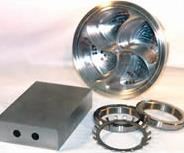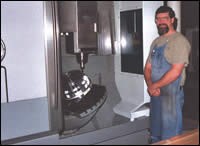Manufacturer Develops High Tolerance, High Volume Parts Niche With Five Axis Mac
Magnus Precision has developed a niche cutting high-volume precision parts in tough materials such as titanium using five-axis machining.
Share




Magnus Precision (Phelps, New York) has developed a niche cutting high-volume precision parts in tough materials such as titanium using five-axis machining. “We call our five-axis capabilities a solution and evolution in part machining, especially for high-tolerance, high-volume intricate parts that require tolerances of 0.0002 inch or better,” says Al Mustardo, vice president of the company.
In 1982, Mr. Mustardo started making molds and dies. There was little repeat business because the parts were mostly one of a kind. Once the engineering was done and the mold or die was machined, the company would not see the job again. Mr. Mustardo began looking for a niche away from the mold and die field. He found it in producing intricate, high-precision, low- to high-volume parts and micro-parts for the medical, aerospace and sports equipment markets. Most of these parts would easily fit in the palm of a hand.
“We went into production machining, because we thought we could get a better return on our investment,” says Mr. Mustardo. “One of the biggest problems with a tooling job like a die, is that you make it once and you never see it again. If there’s any hiccup with the job at all, you don’t have a chance to recover your costs. We felt there was a void in small to high volume, high-tolerance parts, and we thought we could really fill this need using EDM, CNC turning, multi-axis CNC turning and multi-axis milling solutions for companies.” It took Magnus Precision about 5 years to evolve into what it is today.
Magnus Precision bought machine tools with technology that the job shops in the area didn’t offer. The company also developed a core competency in small precision parts. Further, the company exploited its market by offering customers price reductions based on the capabilities of the new equipment. In order to do this machining, the company bought turning centers, electrical discharge machines (EDMs), vertical machining centers (VMCs) and horizontal machining centers (HMCs). At one time, complex parts that required multi-axis machining were placed on different machines.
Before Magnus Precision got into five-axis machining, it developed a four-axis VMC by adding a table on a table. The four-axis VMC didn’t work as well as the company hoped because of volumetric and heat distortion inaccuracies. The company began eliminating VMCs from its production process. Additionally, customer part tolerances became more demanding. “We had to come up with a machine tool that had a configuration that could meet the product specifications,” says Mr. Mustardo. “That was one of the driving forces for five-axis machines. Another driving force was the capability to have a more streamlined process in which the company could bypass a couple of stages, such as EDM work or turning many of the parts. There was also a market opportunity for that quick-turnaround, highly complex part.
Mr. Mustardo bought a DMG DMU five-axis eVolution from DMG (Charlotte, North Carolina). The machine performed so well that within 3 years, the company added four more. “We’ve found that our DMG machines are more precise than our quality-inspection equipment,” Mr. Mustardo adds. The machines helped the company get the precision it needed, with better quality and productivity, by machining the part in one fixturing.
“We went after different markets using our DMU 50 Evolution five-axis capability,” Mr. Mustardo states. “Most job shops in our area can’t offer customers a machining solution with this type of equipment. The biggest core advantage for five-axis in this down economy has been smaller lot sizes with quicker turnaround time. A five-axis machine tool offers a real competitive edge for us, because we can do a prototype job for a customer and have low engineering expenses. Once the part program is written, you can usually put the part on the machine and machine it in one setup and deliver it to the customer. There’s no transferring the part back and forth between other machines, where tolerance problems between fixtures can affect the part’s dimensions, and there’s the elimination of dead time when a part is moved between fixtures and machines.”
The company found that the DMG machines are also flexible. Operators can sometimes bypass turning by milling the part’s outer diameter and having it rounded within an acceptable tolerance range.
Mr. Mustardo says that the five-axis machines have also allowed Magnus to reduce part costs, permitting the company to sell the parts at a lower price. “We are also more productive with the people we have. We have one person running three or four of these five-axis machines.”
Magnus employs two full-time people for programming. Programs are downloaded through Ethernet connections at the machine. “Some of the programs are very long when we doing surfacing. We need this capability,” says Mr. Mustardo.
“The five-axis machining for us is going to evolve in two different directions: a different type of machine tool dedicated towards micro parts, and probably a larger five-axis machine for our larger parts, where the head rotates as opposed to the table and part,” Mr. Mustardo remarks. “I see this company going in two directions to complement what we already have,”
Mr. Mustardo says the company uses three technologies with these machines: robotics on one machine; a 30-pallet changer on another; and a Blum laser, used for tool breakage monitoring and tool length offset, on a third. The company also uses a probe for part measurement and fixture offsets. The company’s biggest five-axis machine is a DMU 70 eVolution having a 30-inch by 24-inch by 21-inch working area.
Mr. Mustardo says that Magnus Precision looked at four machine builders before it ended up buying DMG machine tools. “Five-axis machines weren’t that common 3 1/2 years ago,” he says. “One company had a huge traditional pallet pool. So their solution for automation really wasn’t acceptable for us. DMG had the best all-around accuracy and organizational support. They had integration of the Blum laser and the Renishaw probe worked out. It’s been a good choice; that’s why we bought four more.
“Accuracy has been phenomenal with the DMG machines. In fact, we can’t measure the accuracy of the machine or the roundness of a circle, and we can’t measure the full volumetric, true position of the location, because these machines are more accurate than our measuring equipment, which is very active because of our parts,” he adds.
For parts, Mr. Mustardo says the company is holding 0.001-inch true position, which is pretty common for them with 0.0002-inch to 0003-inch true position for bore sizes.
Magnus Precision now manufacturers all types of parts, including high-precision micro parts in quantities anywhere from one to 20,000 annually.
“In this day and age, you’ve got to support your customer throughout the production process; not just on the prototype release and supplier involvement, but all the way through the production process,” says Ron Kosmider, company president. “We’re taking the technology that the automotive manufacturers have refined and applying it to non-automotive sectors.
“Much of the sales in this area are engineering driven. It’s almost all this way. So you need to engineer solutions for your customers. Engineer a more competitive part, and do whatever is needed. That’s why we made and will make the investment in machining technology.”
Read Next
Building Out a Foundation for Student Machinists
Autodesk and Haas have teamed up to produce an introductory course for students that covers the basics of CAD, CAM and CNC while providing them with a portfolio part.
Read More5 Rules of Thumb for Buying CNC Machine Tools
Use these tips to carefully plan your machine tool purchases and to avoid regretting your decision later.
Read MoreSetting Up the Building Blocks for a Digital Factory
Woodward Inc. spent over a year developing an API to connect machines to its digital factory. Caron Engineering’s MiConnect has cut most of this process while also granting the shop greater access to machine information.
Read More





















.png;maxWidth=300;quality=90)














